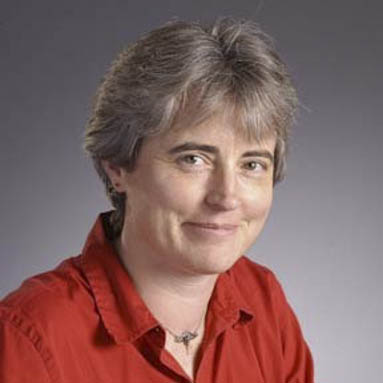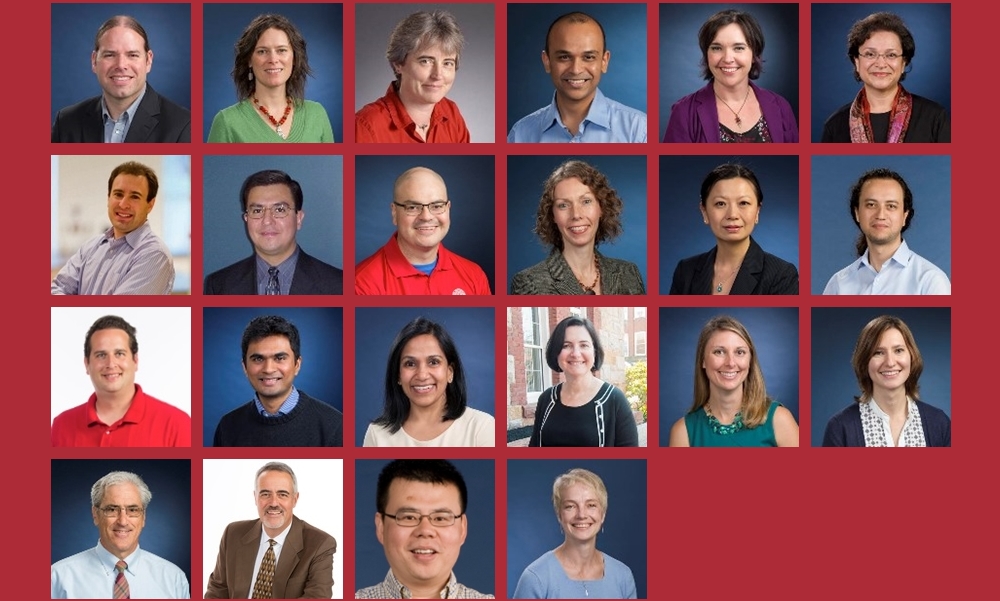Two papers by physicist Nancy Burnham are among the top 25 articles published over the past quarter century in the journal Nanotechnology
Nancy Burnham, center, in the Atomic Force
Microscopy Laboratory.
As Nanotechnology, the first peer-reviewed journal in nanoscale science and technology, prepares to observe its 25th anniversary, its editors have selected 25 papers they consider to be the most important among the nearly 12,000 or so that have appeared in the publication's pages since 1990. Two of those papers are co-authored by Nancy Burnham, associate professor of physics at WPI. In fact, Burnham is the only author to have more than one paper selected for the top-25 list.
One of those two papers, "Comparison of calibration methods for atomic-force microscopy cantilevers," is currently featured on the journal's website, along with a video interview with Burnham. The paper describes work done in Burnham's Atomic Force Microscopy Laboratory in Olin Hall to identify a quick and reliable way that researchers can determine the stiffness of these cantilevers. The method they recommended, which makes use of the cantilever's thermal spectra, is a technique Burnham and her students identified as they were completing the study.
The atomic force microscope (AFM) uses a tiny cantilever with a fine point at one end (Burnham describes it as looking like a miniature diving board) to scan the contours of surfaces at the scale of nanometers (a nanometer is a billionth of a meter). At that scale, the AFM (also known as a scanning force microscope) can image individual molecules and detect minute forces (such as the force a bacterium exerts to cling to cell wall). Since the cantilever's stiffness can be an important factor in calibrating the microscope, Burnham's paper has been extensively consulted and cited.
Nancy Burnham
The other Burnham paper selected by the Nanotechnology editors is titled, "How does a tip tap?" Describing work completed at l’Ecole Polytechnique Fédérale in de Lausanne, Switzerland, where she was a researcher from 1994 to 1999, the article explores the effects of a material's properties (stiffness, adhesiveness, etc.) on the response of the AFM cantilever and the resulting topographic images. Using experimental results obtained with a variety of samples, Burnham's team developed a computer model that can be used to predict the response of the cantilever. The model also helps researchers better understand the results they obtain when using an AFM.
Burnham, who earned her PhD at the University of Colorado, where she conducted a surface analysis of photovoltaic materials for her dissertation, became interested in scanning probe microscopy when she was a National Research Council Postdoctoral Fellow at the Naval Research Laboratory. She continued to pursue her interest in the mechanical properties of nanostructures and instrumentation for nanomechanics as a von Humboldt Fellow at Forschungszentrum Jülich in Germany and during her time in Switzerland. She has also held research appointments at the University of Bordeaux, the Tokyo Institute of Technology, and the Kungliga Tekniska Högskolan in Stockholm.
She joined the WPI physics faculty in 2000 and was also named an affiliated associate professor of biomedical engineering in 2012. She is the author or co-author of more than 70 peer-reviewed publications that have garnered over 7,500 citations, and she has delivered invited, tutorial, or plenary talks at over 40 conferences. She is a fellow of AVS (American Vacuum Society) and currently serves as treasurer of the society's Nanoscience and Technology Division. In 2001 she received the Nanotechnology Recognition Award from AVS, and the following year she was the Institute of Physics of Ireland Lecturer.
In addition to advancing the science of nanotechnology and the AFM, Burnham is passionate about teaching others to use this versatile tool for their own studies of the nanorealm. Toward that end, she teaches an undergraduate and a graduate course on atomic force microscopy. Recognizing the potential to reach a larger audience through online education, she recently set out to bring her AFM lessons to the Web.
"The last time I taught my graduate course, in 2013, I went home every night and made one or two videos and posted them to YouTube," she says. "The next time I teach, I'll assign the videos as homework so we can use more class time for discussion. This is a trend in pedagogy; it's called 'flipping the classroom.'"
Burnham's AFM YouTube channel currently has more than 200 subscribers and the videos there have been viewed more than 26,000 times. It's just one more way that she is having a big impact in a field dedicated to the study of the very small.



